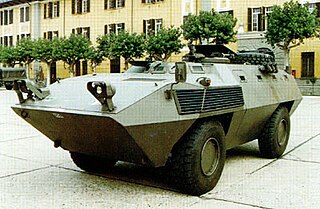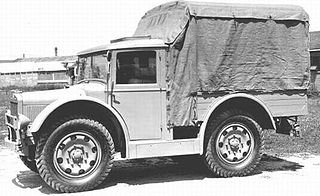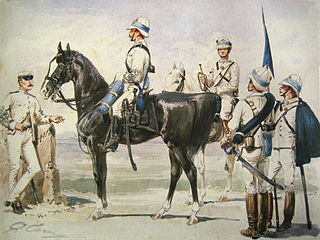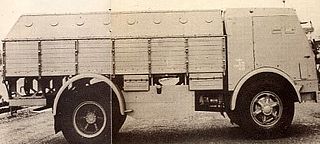
The Lancia 1Z and the Lancia 1ZM were two variations of an Italian armoured car built during World War I and which saw limited service during that war, the interwar period, and during World War II. The name is often misspelled as Lancia IZM.

The Humber armoured car was one of the most widely produced British armoured cars of the Second World War. It supplemented the Humber Light Reconnaissance Car and remained in service until the end of the war.

The BRDM-1 is a Soviet amphibious armored scout car. It was the first purpose-built Soviet reconnaissance vehicle to enter service since the BA-64 and was built on the chassis and drive train of the BTR-40 armored personnel carrier. It is the world's first mass-produced combat vehicle of its class.

The Carro Armato M13/40 was an Italian World War II tank designed to replace the M11/39 in the Royal Italian Army at the start of World War II. It was the primary tank used by the Italians throughout the war. The design was influenced by the British Vickers 6-Ton and was based on the modified chassis of the earlier M11/39. Production of the M11/39 was cut short in order to get the M13/40 into production. The name refers to "M" for Medio (medium) according to the Italian tank weight standards at the time, 13 tonnes was the scheduled weight and 1940 the initial year of production.

The Carro Armato M11/39 was an Italian medium tank first produced prior to World War II. The M11/39 saw service in Africa and Italy (1939–1944). The official Italian designation was Carro Armato M11/39. The designation for the M11/39 is as follows: "M" for Medio ("medium"), followed by the weight in tonnes (11) and the year of adoption (1939).

The Marmon–Herrington armoured car was a series of armoured vehicles that were produced in South Africa and adopted by the British Army during World War II. They were also issued to RAF armoured car companies, which seem never to have used them in action, making greater use of Rolls-Royce armoured cars and other types.

The Lanchester 6×4 armoured car was a British armoured car with a 6×4 drivetrain produced in limited numbers in the late 1920s and early 1930s. A heavier, more rugged development of the earlier Lanchester 4x2 armoured car, it remained in service with Territorial and colonial units until the early 1940s and saw action in the Battle of Malaya.

The Autoblindo 40, 41 and 43 were Italian armoured cars produced by Fiat-Ansaldo and which saw service mainly during World War II. Most autoblinde were armed with a 20 mm Breda 35 autocannon and a coaxial 8 mm machine gun in a turret similar to the one fitted to the Fiat L6/40, and another hull mounted rear-facing 8 mm machine gun.

The L3/35, also known as the Carro Veloce CV-35, was an Italian tankette that saw combat before and during World War II. It was one of the smallest tanks that faced combat. Although designated a light tank by the Italian Army, its turretless configuration, weight and firepower make it closer to contemporary tankettes. It was the most numerous Italian armoured fighting vehicle and saw service almost everywhere the Italians fought in the Second World War but proved inadequate for modern warfare, having too thin armour and weak armament of only machine guns. It was cheaply produced but because of its light armaments and armour it was reserved to mostly colonial, policing, reconnaissance, and supply duties. However, given its low production costs, proved to be efficient in the Second Italo-Abyssinian War, Spanish Civil War and the Greco-Italian War where it provided reliable support to Italian infantry and disrupted enemy lines.

The Fiat 2000 was an Italian heavy tank designed and produced by Fiat during World War I. Only two were built as it never entered serial production. It was one of the largest designs of its time.

The Fiat CM6614 is a 4x4 wheeled armoured personnel carrier developed as a joint venture between Fiat and Oto Melara of Italy. The hull is welded steel, and the vehicle is amphibious. The first prototype was built in 1972.

The SPA AS.37 was an Italian military light truck, used during World War II. The AS.37 Autocarro Sahariano was developed from 1937 on the frame of the TL.37 artillery tractor and was especially conceived to be employed in the North African desert. The most significant improvement of this new vehicle was its increased range: 900 km with added water tanks. The A.S.37 could transport 8 men and their equipment in its rear cargo box.

The Cacciatori d'Africa were Italian light infantry and mounted infantry units raised for colonial service in Africa. Cacciatori units later served in Somalia, Eritrea, Tripolitania and Cyrenaica for the Italian colonial empire. Partially mechanised in the early 1920s, the Cacciatori d'Africa remained part of the Regio Corpo Truppe Coloniali until 1942.

The Auto-Saharan Companies were Italian military units specialised in long range patrols of the Sahara Desert. Companies were formed around expert soldiers, riding AB 41 armored cars and FIAT and Lancia light trucks customized to operate in the desert. The units operated from the late 1930s to the Italian surrender in 1943.

Tanks have been employed by the military forces in Italy since their first use in World War I. They have had continued use in wars after and are still used through the modern day. The C1 Ariete is the current main battle tank of the Italian Army.
The Lancia 1Z was a light military truck produced by Italian manufacturer Lancia between 1912 and 1916. From a mechanical standpoint, it was closely related to the 1913 35 HP Theta passenger car. It was Lancia's first military vehicle.

The Fiat 666 was a heavy truck produced by the Italian Fiat Veicoli Industriali.

The Fiat 665NM protetto (protected) or scudato (shielded) was a wheeled armoured personnel carrier, produced in Italy and employed during World War II by the Royal Italian Army, the National Republican Army and the Wehrmacht.

The Breda 51 was an Italian multi-purpose off-road vehicle developed in the 1930s.

The Fiat Tipo 15 is a light military truck produced by Fiat Veicoli Industriali. Introduced in 1911, the Tipo 15 was used by the Royal Italian Army in the Italo-Turkish War and in the First World War. It was also produced in the Soviet Union as the AMO F-15.




















